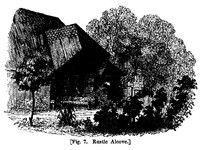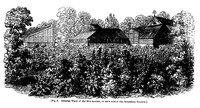The following are the details of the farmyard, garden offices, and hot-houses, as exhibited in Fig. 6:� 1, Rustic alcove, forming a recess under a thatched roof, which covers the space from the green-house, 3, to the houses or yards, 70, 71, and 72. This rustic alcove has the floor paved with small pebbles, and the sides and ceiling lined with young fir-wood, with the bark on. There is a disguised door on the right, which leads to 69, a house for grinding-mills and other machines; and on the left, which leads to 2, the ship-room. In the upper part of the central compartment, in a square recess fronting the entrance, is a white marble statue of the Indian god Gaudama, or Gaudmia. Three Elizabethan benches, each as long as one of the sides of the alcove, are placed so as to disguise the doors. The external appearance of this alcove is shown in Fig. 7. 2, Ship-room, paved with slate, and with the walls finished in stucco, and ceiling with beams painted like oak, to which are hung Indian spears, and other curiosities, and serving to contain models of ships and vessels of various sorts during winter. These are placed on the pond in the summer season; square-rigged vessels at fixed anchorage, and the fore-and-aft-rigged ones, whose sails traverse, such as schooners, cutters, and coasting vessels, with cables of lengths to allow of their sailing without touching the edge of the pond; and these continue constantly traversing the pond when there is any wind. This room also contains a variety of the warlike instruments of the savages of different countries, a bust of Lord Nelson, one of the Duke of Wellington, some pictures in mosaic, and a number of East Indian curiosities. It serves also as a lobby to the orangery. 3, The orangery. The paths are of slate, and the centre bed, or pit, for the orange trees, is covered with an open wooden grating, on which are placed the smaller pots; while the larger ones, and the boxes and tubs, are let down through openings made in the grating, as deep as it may be necessary for the proper effect of the heads of the trees. This house, and that for Orchidace�, are heated from the boiler indicated at 61. 4, Orchidaceous and fern house, in which a is the stage for Orchidace�, and b a cone of rockwork, chiefly of vitrified bricks, for ferns. These ferns, amounting to above two dozen species, all sprang up accidentally from the soil attached to some plants which were sent to Mr. Harrison from Rio Janeiro and other parts of South America. The shelves round the house are also occupied with Orchidace�, all of which are in pots, in order that, when they come into flower, they may be removed to the green-house; as, when thus treated, as practised by the Duke of Devonshire at Chatsworth, they continue much longer in bloom than when kept in the degree of heat necessary for their growth. 4 c, Lobby between the orangery (3) and the conservatory (5). 4 d, An aviary for canaries, separated from the conservatory and the lobby by a wire grating, and from the orchidaceous house by a wall. Both the aviary and the lobby have a glass roof in the same plane as that of the conservatory, as may be seen in Fig. 8, in p. 499. In the winter season the temperature of the aviary being the same as that of the conservatory, the birds require little or no care, except giving them food; while they sing freely at that season, and greatly enliven this part of the garden scenery. 5, Conservatory, with vines under the rafters. The walks are slate, the shrubs are planted in a bed of free soil edged with slate, and the back wall is covered with different species of Passiflora, and with the Tacsonia pinnatistipula. 6, Camellia-house. The camellias kept in pots; the rafters covered with vines, and the back wall with passifloras and other climbers. This house, and also 5, are heated from one boiler, as indicated at 64. 7, Geranium-house. The roof is in the ridge and furrow manner of Mr. Paxton. This house, and also 8. 9, and 10, are heated from the boiler indicated at 89. 8, Botanic stove. The roof is in the ridge and furrow manner of Paxton. The sides of the pit are formed of slabs of slate; and there is a slate box at e, containing a plant of Musa Cavendishii with a spike of fruit, two or three of which ripen off weekly. F. is a cistern for stove aquatics. There is a plant of Brugmansia suavolens (Datura arborea L.) 15 ft. high, with a head 13 ft. in diameter. When we saw it, Aug. 10th, 277 blossoms were expanded at once, producing an effect upon the spectator under the tree, when looking up, which no language can describe. Last year it produced successions of blossoms, in one of which 600 were fully expanded at one time. This year it has had five successions of blossoms, and another is now coming out as the plant expands in growth. There is a large Brugmansia coccinea in this house. Both these plants are in the free soil. 9, House for Cape heaths. 10, Pinery. The roof of this house is in the ridge and furrow manner, in imitation of Mr. Paxton's mode; from which it differs, in having the ridge about one-third higher in proportion to the breadth, in having the sash-bar deeper, and placed at right angles to the crown of the ridge and to the furrow, and in having the panes of twice the size which they are in Mr. Paxton's roof. This house was built by Mr. Harrison's carpenter, from the general idea given to him; and before he had been to Chatsworth to examine the original house with this kind of roof, built there by Mr. Paxton. 11, Cucumber-pit, on M'Phail's plan. 12, Succession pine-pit, also on M'Phail's plan, in order to be heated with dung linings. 13, Melon-pit. 14, Dutch cold-pit, for preserving lettuces, cauliflowers, etc., during winter. 15, Tool-house and potting-shed; the tools regularly hung on irons fixed to the ceiling, or set against the wall, or laid on shelves. the place for each sort of tool or implement, ropes, etc., being painted in large white letters on black boards. The following rules are painted on a board which is hung up in the tool-house:�





